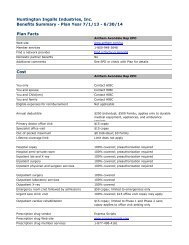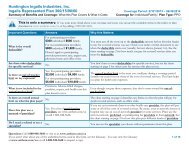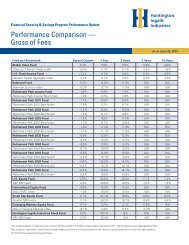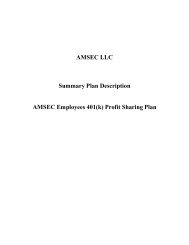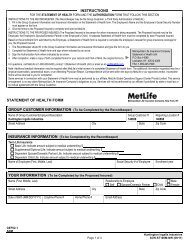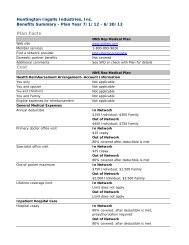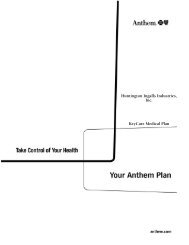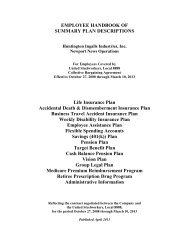Huntington Ingalls Industries Savings Plan ... - Benefits Connect
Huntington Ingalls Industries Savings Plan ... - Benefits Connect
Huntington Ingalls Industries Savings Plan ... - Benefits Connect
You also want an ePaper? Increase the reach of your titles
YUMPU automatically turns print PDFs into web optimized ePapers that Google loves.
<strong>Huntington</strong> <strong>Ingalls</strong> <strong>Industries</strong><br />
<strong>Savings</strong> <strong>Plan</strong> SPD<br />
March 2011<br />
Naming Your Beneficiary<br />
When you enroll in the <strong>Savings</strong> <strong>Plan</strong>, you need to designate a primary beneficiary(ies) —<br />
the individual(s), estate, or trust that will receive your <strong>Savings</strong> <strong>Plan</strong> benefits in the event<br />
of your death. You can also name other beneficiaries — called contingent beneficiaries —<br />
who will receive your account balance if you and your primary beneficiary(ies) die before<br />
receiving your <strong>Savings</strong> <strong>Plan</strong> benefits.<br />
If your account balance was transferred to this <strong>Plan</strong> from the Northrop Grumman <strong>Savings</strong><br />
<strong>Plan</strong> (NGSP) within 45 days of the Spin-Off, your beneficiary designation under the<br />
NGSP will be effective under this <strong>Plan</strong>. You are encouraged to periodically review your<br />
beneficiary designation.<br />
Primary beneficiary — Anyone listed as a primary beneficiary receives your plan<br />
benefits first upon your death. If you name more than one primary beneficiary when you<br />
enroll, you must indicate the percentage of your <strong>Savings</strong> <strong>Plan</strong> account balance that each<br />
beneficiary will receive in the event of your death. If any primary beneficiary dies before<br />
you, his or her percentage is divided equally among the surviving primary beneficiaries (if<br />
any). If all primary beneficiaries die before you, then your plan benefits are paid to your<br />
contingent beneficiaries who survive you. If no contingent beneficiaries are named, or<br />
they die before you, your benefits will be paid to your surviving spouse, if any, or to your<br />
estate.<br />
Contingent beneficiary — Anyone listed as a contingent beneficiary receives your plan<br />
benefits only if all of your primary beneficiaries are deceased at the time of your death. If<br />
more than one person is designated as a contingent beneficiary, then each one receives<br />
the percentage you designate. If any contingent beneficiary dies before you, his or her<br />
percentage is divided equally and paid to the surviving contingent beneficiaries. If there<br />
are no surviving contingent beneficiaries, your benefit is paid to your surviving spouse, if<br />
any, or to your estate.<br />
Estate or trust as beneficiary — If an estate or trust is designated as beneficiary, the<br />
<strong>Plan</strong> Administrator and its agents have no obligation to determine the validity or<br />
sufficiency of any executed estate or trust agreement, or to pass judgment on its legality.<br />
In making any payment to a trustee, the <strong>Plan</strong> Administrator and its agents have the right<br />
to assume that the trustee is acting in a fiduciary capacity until notice to the contrary is<br />
received. The <strong>Plan</strong> Administrator and its agents are not liable for any payments made to<br />
the trustee prior to their receipt of such notice.<br />
If you are single, you must complete a form that indicates your single status. You can<br />
name any individual(s) or trust as a beneficiary. If you do not choose a beneficiary, your<br />
beneficiary is your estate.<br />
If you are married, your beneficiary automatically is your spouse. However, if you want<br />
to designate someone other than your spouse as your primary beneficiary, your spouse<br />
must sign the <strong>Plan</strong>’s beneficiary designation form (which will be mailed to you at your<br />
request), and his or her signature must be notarized.<br />
18




